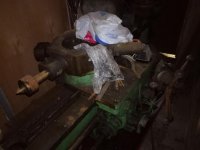Hello from Finland.
My father in law had this Gisholt lathe and I´m thinking about bringing this old thing back to life. I've never even seen or heard about Gisholt before now, so I'm asking some specs for that. My father in law has passed away before I got a chance to meet him. So no help from him. There are few parts they have chanced and he's done some machining with it about 10 years ago.
Are those tough workers or am I getting more problems to my garage?
How much does that thing weight?
All the specs are helpfull. I don't even know the exact type.
Few photos I have, are taken in dark, dusty, little garage and it's 150 miles away. So more or better pics I can't get now. Maybe later.
And sorry for my english. I don't know the vocabulary in this matter.
-Tomi
My father in law had this Gisholt lathe and I´m thinking about bringing this old thing back to life. I've never even seen or heard about Gisholt before now, so I'm asking some specs for that. My father in law has passed away before I got a chance to meet him. So no help from him. There are few parts they have chanced and he's done some machining with it about 10 years ago.
Are those tough workers or am I getting more problems to my garage?
How much does that thing weight?
All the specs are helpfull. I don't even know the exact type.
Few photos I have, are taken in dark, dusty, little garage and it's 150 miles away. So more or better pics I can't get now. Maybe later.
And sorry for my english. I don't know the vocabulary in this matter.
-Tomi





















